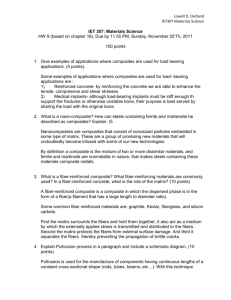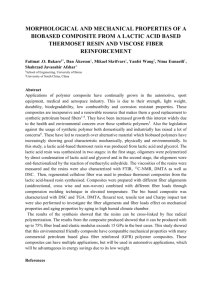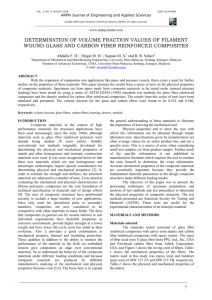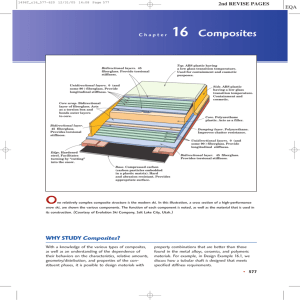Chap 17 Learn Obj
advertisement
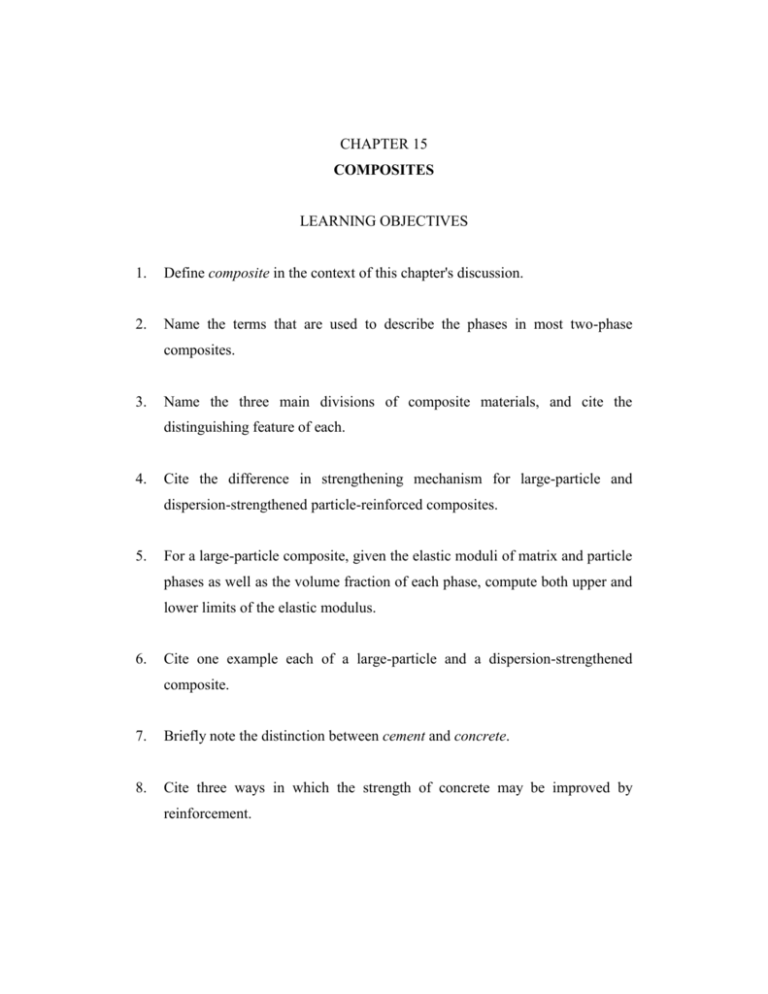
CHAPTER 15 COMPOSITES LEARNING OBJECTIVES 1. Define composite in the context of this chapter's discussion. 2. Name the terms that are used to describe the phases in most two-phase composites. 3. Name the three main divisions of composite materials, and cite the distinguishing feature of each. 4. Cite the difference in strengthening mechanism for large-particle and dispersion-strengthened particle-reinforced composites. 5. For a large-particle composite, given the elastic moduli of matrix and particle phases as well as the volume fraction of each phase, compute both upper and lower limits of the elastic modulus. 6. Cite one example each of a large-particle and a dispersion-strengthened composite. 7. Briefly note the distinction between cement and concrete. 8. Cite three ways in which the strength of concrete may be improved by reinforcement. 9. Given the elastic modulus, tensile strength, and density (in grams per cubic centimeter) of a material, compute its specific stiffness and specific strength. 10. Given fiber strength and diameter, and magnitudes of the fiber-matrix interfacial bond and shear yield strength, determine the critical fiber length for effective reinforcement. 11. Make the distinction between continuous and discontinuous fibers. 12. Make a schematic sketch of the load sustained by the fiber as a function of position along the fiber length for (a) a fiber of critical length, and (b) a fiber of length greater than the critical. 13. (a) Distinguish the three different types of fiber-reinforced composites on the basis of fiber length and orientation. (b) Comment on the distinctive mechanical characteristics for each type. 14. Make a schematic plot of stress versus strain, and include curves for the following: (a) fiber and matrix phases that have mechanical properties typical of those used for fibrous composites; and (b) a composite that consists of these continuous and aligned fibers embedded in this matrix material, and for which loading is in the longitudinal direction. 15. For an aligned and continuous fiber-reinforced composite, given volume fractions and elastic moduli of fiber and matrix phases, be able to compute the elastic modulus in each of longitudinal and transverse directions. 16. Compute the longitudinal strength for a continuous and aligned fibrous composite given values for fiber strength, matrix stress at fiber failure, and fiber volume fraction. 17. For a discontinuous and aligned fibrous composite, compute the longitudinal strength for (a) lc < l < 15lc and (b) l < lc, given the following values: fiber strength, critical and actual fiber lengths, matrix stress at fiber fracture, fibermatrix bond strength, and shear yield strength of the matrix phase. 18. Compute the strength for a discontinuous and randomly oriented fibrous composite, given values for the fiber efficiency parameter, elastic moduli for fiber and matrix phases, as well as phase volume fractions. 19. Be able to cite the three classes of fibers, and, for each, the distinctive characteristics and at least two examples (of materials). 20. Cite three functions that the matrix phase serves for fiber-reinforced composites. 21. (a) Note the three common fiber reinforcements used in polymer-matrix composites. (b) For each, cite both desirable characteristics and limitations. (c) Note at least three common applications for each of these PMC types. 22. For metal-matrix composite materials (a) list the most commonly used matrix and fiber materials, and (b) cite the main advantages of these materials over the PMCs. 23. Note the primary reason for the creation of ceramic-matrix composites. 24. Briefly describe the mechanism of transformation toughening. 25. For carbon-carbon composites, briefly discuss (a) the processing technique employed, (b) their desirable properties, and (c) principal applications. 26. (a) Define hybrid composite. (b) Cite the principal advantage for using this type of composite. 27. (a) Briefly describe each of the three fiber-reinforcement composite processing techniques discussed in this chapter. (b) Discuss principal advantages for the employment of each technique. 28. Name and briefly describe the two subclassifications of structural composites. 29. Cite the principal advantage of using a structural laminate. 30. Name the two sandwich panel components, and at least one function that each component serves. 31. Briefly describe the construction of a honeycomb structure.



